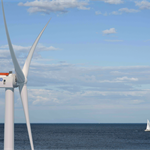Reality check: Facts and figures behind UK’s windy rhetoric
Energy Disrupter

Boris Johnson today announced support for the UK’s offshore wind sector, setting a new floating offshore wind target, unveiling investment packages for ports and infrastructure, and reheating previous pledges.
Here, Windpower Monthly takes a look at some of the key messages and claims from today’s announncement.
£160 million investment
“£160 million will be made available to upgrade ports and infrastructure across communities like in Teesside and Humber in Northern England, Scotland and Wales… [this investment would be made in] ports, factories and the supply chains, manufacturing the next-generation of offshore wind turbines and delivering clean energy to the UK,” according to the government’s press release.
Johnson today pledged £160 million (€176 million) to upgrade ports and factories for building offshore wind turbines and infrastructure, in a speech to his Conservative Party’s virtual conference.
But analysts at Aurora Energy Research have argued that the 40GW offshore wind target will require nearly £50 billion in investment – a sum significantly greater than the £160 million to be pledged today. The UK government had pledged to invest “more than £40 billion” in UK energy infrastructure when it announced its “sector deal” with the wind power industry last March.
It is possible that today’s announcement of £160 million for ports and factories will precede further investment to be announced later this year.
UK energy minister Alok Sharma yesterday told the party conference that a long-delayed energy white paper – which would set the course for onshore wind, solar, hydrogen and carbon capture – is due to be published this autumn.
The UK government also confirmed that it is due to unveil a new ten-point plan for a “green industrial revolution” later this year.
1GW floating offshore wind capacity
Today’s announcement also creates “a new target for floating offshore wind to deliver 1GW of energy by 2030, which is over 15 times the current volumes worldwide,” the government claimed.
Confusion over energy generation and capacity aside, this is one of few new details from today’s announcement.
Johnson’s boast that the target is more than 15 times the capacity currently online globally is just about correct: Windpower Intelligence has records of 67MW of operational floating wind capacity globally.
However, this 1GW is less than what is currently planned in other markets. For example, it is less than half of the floating offshore wind capacity Macquarie-owned Green Investment Group (GIG) and French oil and gas giant Total plan to build off South Korea by 2030. France also aims to auction 6.5GW of floating offshore wind capacity before 2030 – although it is unclear how much of this will be operational by then.
40GW UK offshore wind target
Today’s announcement confirms “boosting the government’s previous 30GW target to 40GW”.
As the government alludes to, the 40GW by 2030 target is not new.
It had originally aimed for 30GW by 2030 when it agreed the sector deal with the UK wind power industry last year, but this target was later raised to 40GW in the Conservative Party’s manifesto for the December 2019 general election.
This target, then, is not new, but has now been confirmed.
It is not clear, however, whether the 1GW of floating capacity targeted by 2030 will be included in the UK government’s wider offshore wind ambitions.
‘Wind power will provide all UK household energy by 2030’
“Offshore wind will produce more than enough electricity to power every home in the country by 2030… based on current electricity usage,” according to the government’s press release.
Meanwhile, Johnson told his party conference: “Your kettle, your washing machine, your cooker, your heating, your plug-in electric vehicle – the whole lot of them will get their juice cleanly and without guilt from the breezes that blow around these islands.”
There is a lot of wishful thinking in here.
Much of domestic heating and cooking in the UK relies on gas at present.
While the government has banned gas-based heating in new homes from 2025, though still allowing gas cookers, it seems highly unlikely that “every home in the UK” will have changed its central heating system to a more carbon-neutral alternative — and/or everyone will have ditched their petrol/diesel car — by 2030.
In 2018 the UK consumed 106TWh of electricity and 325TWh of gas, according to the latest government figures. it is difficult to predict how gas will be phased back and how other policies – especially those regarding the electrification of hard-to-abate sectors such as heating and transport – may alter this split between electricity and gas.
In 2019, offshore wind generated 31.9TWh in 2019, according to government figures. By the end of the year, the UK’s total offshore wind capacity reached 9.4GW – less than a quarter of the capacity target for 2030. It is also difficult to predict how energy demand may change between now and 2030, but offshore wind will need to generate much more electricity and there will be a greater need for electricifcation if offshore wind is to meet UK households’ entire energy demand.
Doubling down on CfD
The government’s press release also refers to “setting a target to support up to double the capacity of renewable energy in the next contracts for difference auction”.
The UK government is due to hold its next contracts for difference (CfD) tender next year. For the first time in six years, onshore wind will be eligible to compete in 2021.
It is not yet clear what the government’s “target to support up to double the capacity of renewable energy” means.
Will the government increase the budget for next year’s tender?
Or is it relying on price reductions? If the budget remains the same as planned, but developers are seeking lower prices, then more capacity can be awarded for the same amount
This is unclear.
Sneering at wind power
“Some people used to sneer at wind 20 years ago and say it would not pull the skin off a rice pudding,” Johnson told the Conservative Party conference.
Announcing the new support for offshore wind at the Conservative Party’s virtual conference, Johnson said: “Some people used to sneer at wind 20 years ago and say it would not pull the skin off a rice pudding”.
Except he didn’t say this 20 years ago, it was seven years ago.














